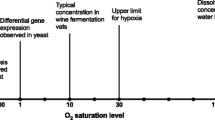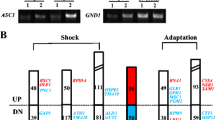Abstract
Acetic acid inhibition of yeast fermentation has a negative impact in several industrial processes. As an initial step in the construction of a Saccharomyces cerevisiae strain with increased tolerance for acetic acid, mutations conferring resistance were identified by screening a library of deletion mutants in a multiply auxotrophic genetic background. Of the 23 identified mutations, 11 were then introduced into a prototrophic laboratory strain for further evaluation. Because none of the 11 mutations was found to increase resistance in the prototrophic strain, potential interference by the auxotrophic mutations themselves was investigated. Mutants carrying single auxotrophic mutations were constructed and found to be more sensitive to growth inhibition by acetic acid than an otherwise isogenic prototrophic strain. At a concentration of 80 mM acetic acid at pH 4.8, the initial uptake of uracil, leucine, lysine, histidine, tryptophan, phosphate, and glucose was lower in the prototrophic strain than in a non-acetic acid-treated control. These findings are consistent with two mechanisms by which nutrient uptake may be inhibited. Intracellular adenosine triphosphate (ATP) levels were severely decreased upon acetic acid treatment, which likely slowed ATP-dependent proton symport, the major form of transport in yeast for nutrients other than glucose. In addition, the expression of genes encoding some nutrient transporters was repressed by acetic acid, including HXT1 and HXT3 that encode glucose transporters that operate by facilitated diffusion. These results illustrate how commonly used genetic markers in yeast deletion libraries complicate the effort to isolate strains with increased acetic acid resistance.


Similar content being viewed by others
References
Almeida B, Ohlmeier S, Almeida AJ, Madeo F, Leão C, Rodrigues F, Ludovico P (2009) Yeast protein expression profile during acetic acid-induced apoptosis indicates causal involvement of the TOR pathway. Proteomics 445(9):720–732
Andreasson C, Ljungdahl PO (2002) Receptor-mediated endoproteolytic activation of two transcription factors in yeast. Genes Dev 16:3158–3172
Auesukaree C, Homma T, Kaneko Y, Harashima S (2003) Transcriptional regulation of phosphate-responsive genes in low-affinity phosphate transporter-defective mutants in Saccharomyces cerevisiae. Biochem Biophys Res Commun 306:843–850
Baudin A, Ozier-Kalogeropoulos O, Denouel A, Lacroute F, Cullin C (1993) A simple and efficient method for direct gene deletion in Saccharomyces cerevisiae. Nucl Acid Res 21:3329–3330
Bauer BE, Rossington D, Mollapour M, Mamnun Y, Kuchler K, Piper PW (2003) Weak organic acid stress inhibits aromatic amino acid uptake by yeast, causing a strong influence of amino acid auxotrophies on the 23 phenotypes of membrane transporter mutants. Eur J Biochem 270:3189–3195
Beck T, Schmidt A, Hall MN (1999) Starvation induces vacuolar targeting and degradation of the tryptophan permease in yeast. J Cell Biol 146:1227–1238
Boer VM, Amini S, Botstein D (2008) Influence of genotype and nutrition on survival and metabolism of starving yeast. Proc Natl Acad Sci USA 105:6930–6935
Brachmann CB, Davies A, Cost GJ, Caputo E, Li J, Hieter P, Boeke JD (1998) Designer deletion strains derived from Saccharomyces cerevisiae S288C: a useful set of strains and plasmids for PCR-mediated gene disruption and other applications. Yeast 14:115–132
Burke D, Dawson D, Stearns T (2000) Methods in yeast genetics: a Cold Spring Harbor Laboratory course manual. Cold Spring Harbor Laboratory Press, Cold Spring Harbor
Carmelo V, Santos H, Sá-Correia I (1997) Effect of extracellular acidification on the activity of plasma membrane ATPase and on the cytosolic and vacuolar pH of Saccharomyces cerevisiae. Biochim Biophys Acta 1325:63–70
Cherest H, Davidian J-C, Thomas D, Benes V, Ansorge W, Surdin-Kerjan Y (1997) Molecular characterization of two high affinity sulfate transporters in Saccharomyces cerevisiae. Genetics 145:627–635
Eraso P, Gancedo C (1987) Activation of yeast plasma membrane ATPase by acid pH during growth. FEBS Lett 224:187–192
Giannattasio S, Guaragnella N, Corte-Real M, Passarella S, Marra E (2005) Acid stress adaptation protects Saccharomyces cerevisiae from acetic acid induced programmed cell death. Gene 354:93–98
Gietz D, St. Jean A, Woods RA, Schiestl RH (1992) Improved method for high efficiency transformation of intact yeast cells. Nucl Acid Res 20:1425
Horák J (1997) Yeast nutrient transporters. Biochim Biophys Acta 1331:41–79
Hueso G, Aparicio-Sanchis R, Montesinos C, Lorenz S, Murguía JR, Serrano R (2012) A novel role for protein kinase Gcn2 in yeast tolerance to intracellular acid stress. Biochem J 441:255–264
Jiang Y, Broach JR (1999) Tor proteins and protein phosphatase 2A reciprocally regulate Tap42 in controlling cell growth in yeast. EMBO J 18:2782–2792
Jones CB, Ott EM, Keener JM, Curtiss M, Sandrin V, Babst M (2012) Regulation of membrane protein degradation by starvation-response pathways. Traffic 13:468–482
Kawahata M, Masaki K, Fujii T, Lefuji H (2006) Yeast genes involved in response to lactic acid and acetic acid: acidic conditions caused by the organic acids in Saccharomyces cerevisiae cultures induce expression of 25 intracellular metal metabolism genes regulated by Aft1p. FEMS Yeast Res 6:924–936
Kitanovic A, Bonowski F, Heigwer F, Ruoff P, Kitanovic I, Ungewiss C, Wölfl S (2012) Acetic acid treatment in S. cerevisiae creates significant energy deficiency and nutrient starvation that is dependent on the activity of the mitochondrial transcriptional complex Hap2-3-4-5. Front Oncol 2:118
Li B-Z, Yuan Y-J (2010) Transcriptome shifts in response to furfural and acetic acid in Saccharomyces cerevisiae. Appl Microbiol Biotechnol 86:1915–1924
Loewith R, Hall MN (2011) Target of rapamycin (TOR) in nutrient signaling and growth control. Genetics 189:1177–1201
Ludovico P, Sousa MJ, Silva MT, Leão C, Corte-Real M (2001) Saccharomyces cerevisiae commits to a programmed cell death process in response to acetic acid. Microbiol 147:2409–2415
Macpherson N, Shabala L, Rooney H, Jarman MG, Davies JM (2005) Plasma membrane H+ and K+ transporters are involved in the weak-acid preservative response of disparate food spoilage yeasts. Microbiol 151:1995–2003
Melin P, Stratford M, Plumridge A, Archer DB (2008) Auxotrophy for uridine increases the sensitivity of Aspergillus niger to weak-acid preservatives. Microbiol 154:1251–1257
Mira NP, Palma M, Guerreiro JF, Sá-Correia I (2010a) Genome-wide identification of Saccharomyces cerevisiae genes required for tolerance to acetic acid. Microb Cell Fact 9:79
Mira NP, Teixeira MC, Sá-Correia I (2010b) Adaptive response and tolerance to weak acids in Saccharomyces cerevisiae: a genome-wide view. OMICS J Integr Biol 14:525–540
Mollapour M, Piper PW (2007) Hog1 mitogen-activated protein kinase phosphorylation targets the yeast Fps1 aquaglyceroporin for endocytosis, thereby rendering cells resistant to acetic acid. Molec Cell Biol 27:6446–6456
Narendranath NV, Thomas KC, Ingledew WM (2001) Effects of acetic acid and lactic acid on the growth of Saccharomyces cerevisiae in a minimal medium. J Indust Microbiol Biotechnol 26:171–177
Pampulha ME, Loureiro-Dias MC (2000) Energetics of the effect of acetic acid on growth of Saccharomyces cerevisiae. FEMS Microbiol Lett 184:69–72
Pfaffl MW (2001) A new mathematical model for relative quantification in real time RT-PCR. Nucl Acid Res 29:e45
Piper P, Calderon CO, Hatzixanthis K, Mollapour M (2001) Weak acid adaptation: the stress response that confers yeasts with resistance to organic acid food preservatives. Microbiol 147:2635–2642
Seifar RM, Cor R, van Dam JC, van Gulik WM, Heijnen JJ, van Winden WA (2009) Simultaneous quantification of free nucleotides in complex biological samples using ion pair reversed phase liquid chromatography isotope dilution tandem mass spectrometry. Anal Biochem 388:213–219
Serrano R (1991) Transport across yeast vacuolar and plasma membranes. In: Broach JR, Pringle JR, Jones EW (eds) The molecular and cellular biology of the yeast Saccharomyces, vol. I. Genome dynamics, protein synthesis, and energetics. Cold Spring Harbor Laboratory Press, Plainview, pp 523–585
Tomás-Cobos L, Viana R, Sanz P (2005) TOR kinase pathway and 14-3-3 proteins regulate glucose-induced expression of HXT1, a yeast low-affinity glucose transporter. Yeast 22:471–479
Winzeler EA, Shoemaker DD, Astromoff A, Liang H, Anderson K, Andre B, Bangham R, Benito R, Boeke JD, Bussey H, Chu AM, Connelly C, Davis K, Dietrich F, Dow SW, El Bakkoury M, Foury F, Friend SH, Gentalen E, Giaever G, Hegemann JH, Jones T, Laub M, Liao H, Liebundguth N, Lockhart DJ, Lucau-Danila A, Lussier M, M’Rabet N, Menard P, Mittmann M, Pai C, Rebischung C, Revuelta JL, Riles L, Roberts CJ, Ross- MacDonald P, Scherens B, Snyder M, Sookhai-Mahadeo S, Storms RK, Véronneau S, Voet M, Volckaert G, Ward TR, Wysocki R, Yen GS, Yu K, Zimmermann K, Philippsen P, Johnston M, Davis RW (1999) Functional characterization of the S. cerevisiae genome by gene deletion and parallel analysis. Science 285:901–906
Yenush L, Merchan S, Holmes J, Serrano R (2005) pH-responsive, posttranslational regulation of the Trk1 potassium transporter by the type 1-related Ppz1 phosphatase. Mol Cell Biol 25:8683–8692
Yoshida A, Wei D, Nomura W, Izawa S, Inoue Y (2012) Reduction of glucose uptake through inhibition of hexose transporters and enhancement of their endocytosis by methylglyoxal in Saccharomyces cerevisiae. J Biol Chem 287:701–711
Acknowledgments
We thank Garrett Holzwarth, Yan Campbell, and Chunxiao Guo for the technical assistance and Adrian Gombart and the Oregon State University (OSU) Linus Pauling Institute for the use of the luminometer and RT-qPCR system. The OSU Environmental Health Sciences Center (grant number P30 ES000210; NIEHS, NIH) provided the yeast deletion library. This work was supported by grant no. 2010-65504-20345 from the United States Department of Agriculture National Institute of Food and Agriculture (USDA-NIFA) program.
Conflict of interest
None.
Author information
Authors and Affiliations
Corresponding author
Electronic supplementary material
Below is the link to the electronic supplementary material.
ESM 1
(PDF 88.1 kb)
Rights and permissions
About this article
Cite this article
Ding, J., Bierma, J., Smith, M.R. et al. Acetic acid inhibits nutrient uptake in Saccharomyces cerevisiae: auxotrophy confounds the use of yeast deletion libraries for strain improvement. Appl Microbiol Biotechnol 97, 7405–7416 (2013). https://doi.org/10.1007/s00253-013-5071-y
Received:
Revised:
Accepted:
Published:
Issue Date:
DOI: https://doi.org/10.1007/s00253-013-5071-y




